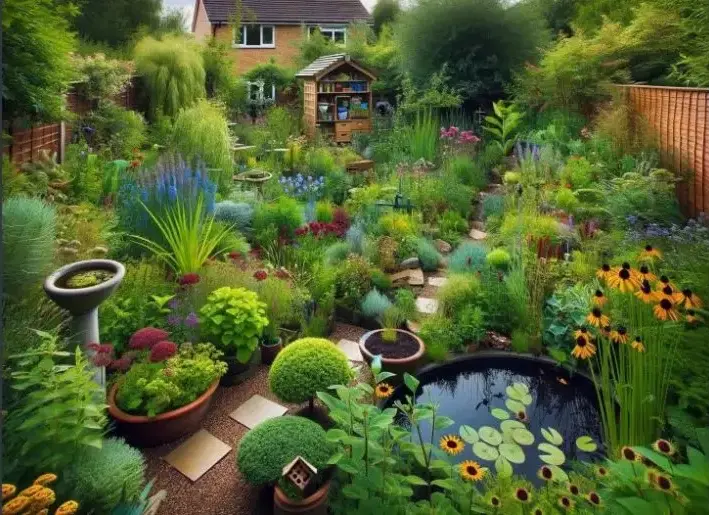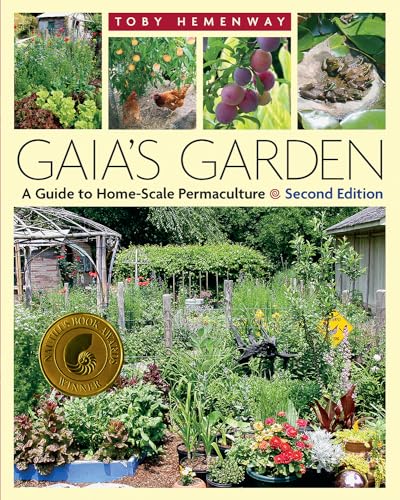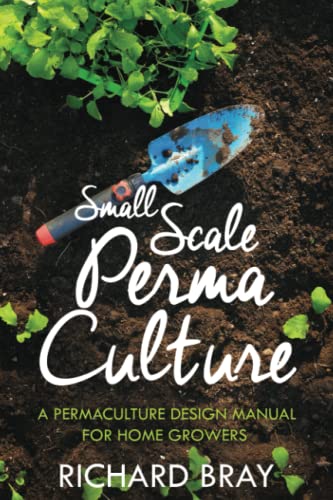Uncover transformative permaculture yard concepts for making a sustainable oasis. Analysis eco-friendly gardening methods adaptable to any house.
Permaculture Gardening Key Takeaways:
- Permaculture gardening emphasizes creating self-sustaining ecosystems adaptable to any house.
- These gardens modify to pure patterns, improve biodiversity, and cut back the necessity for exterior inputs, representing an eco-friendly gardening methodology.
Begin on a journey into the world of permaculture gardening.
This technique adapts to fairly a number of areas, from massive backyards to small balconies, turning them into thriving, eco-friendly environments.
We uncover revolutionary gardening strategies that work in concord with nature, for a further sustainable and fulfilling gardening expertise.
Permaculture Yard Concepts: Sustainable Gardening at Its Largest
Embark on an inspiring journey through the world of permaculture yard concepts, the place sustainability meets creativity.
This half is devoted to exploring a wide range of permaculture methods and ideas that can rework any yard house, massive or small, correct proper right into a thriving, eco-friendly ecosystem.
From revolutionary layouts and plant picks to water administration and wildlife integration, these concepts are designed to encourage and information you in making a yard that not solely seems beautiful nonetheless in addition to contributes positively to the surroundings.
Whether or not or not or not you’re a seasoned gardener or simply beginning out, these permaculture concepts will give you the information and inspiration wanted to domesticate a sustainable and harmonious outdoor house.
A permaculture yard is a design that mimics nature with the intention to yard organically, encourage the suitable wildlife and have a low-maintenance yard multi helpful hit. Properties and Gardens
Permaculture Yard Format:
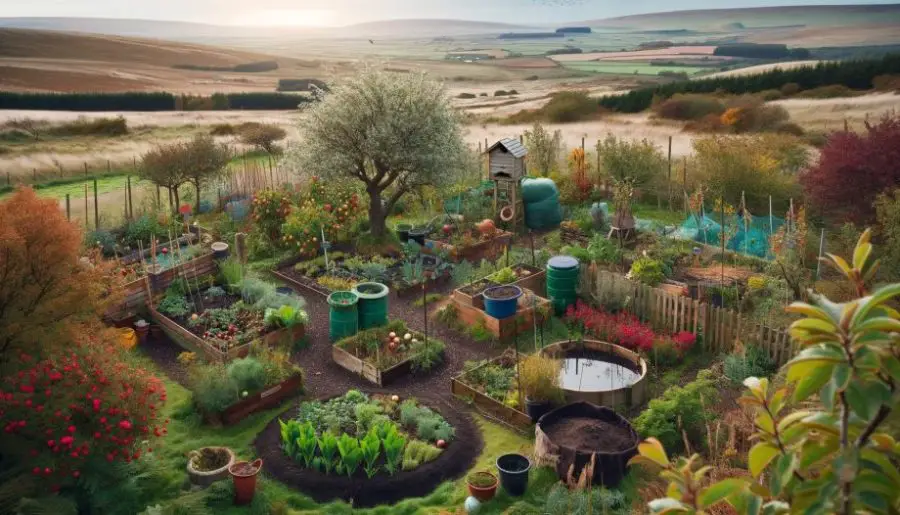
Permaculture yard layouts are essential for sustainable, setting nice gardening.
This system prioritizes making a self-sustaining ecosystem in concord with nature.
A well-designed development considers native native local weather, soil top of the range, and property, remodeling your yard correct proper right into a productive haven.
Integrating permaculture ideas into your yard design not solely beautifies your outdoor house nonetheless in addition to positively impacts the surroundings.
We’ll uncover key parts of permaculture yard layouts and their surroundings pleasant implementation.
Understanding Your Residence:
Permaculture Gardening for the Absolute Newbie
To create a thriving permaculture yard, understanding the precise traits of your individual house is essential.
This comprises an in depth evaluation of assorted environmental components and the accessible property. Correct proper right here’s one of many easiest methods to broaden on this:
Web site Evaluation:
-
- Daylight Patterns: Monitor the photograph voltaic’s motion all via your yard all by the day. Observe areas that purchase full photograph voltaic, partial shade, or full shade. This information is critical for selecting crops suited to every gentle state of affairs.
- Wind Course: Observe the course and power of prevailing winds. Wind patterns can affect plant enchancment, moisture retention, and temperature in your yard.
- Soil Circumstances: Look at your soil for pH diploma, texture, and nutrient content material materials supplies. Understanding soil sort helps in deciding on related crops and figuring out if soil amendments are wanted.
- Topography: Ponder the slope and elevation variations in your yard. This impacts drainage and the microclimates inside your individual house. For example, slopes can result in sooner water runoff, requiring particular methods to retain moisture.
Useful helpful useful resource Evaluation:
-
- Rainwater: Assess how rainwater flows and collects in your yard. Figuring out pure assortment components can information the position of rain gardens or water catchment packages.
- Compost Gives: Look for pure waste sources like kitchen scraps, yard waste, or area people compost capabilities. These is prone to be turned worthwhile compost in your yard.
- Current Vegetation: Analysis the crops presently thriving in your individual house. They will present clues about soil top of the range and microclimates. Some present vegetation is vulnerable to be helpful and is prone to be built-in into your permaculture design.
- Native Native local weather and Native climate Patterns: Understanding your native native local weather, together with seasonal temperature ranges and precipitation patterns, is important. This influences plant choice and yard planning.
By conducting a radical evaluation of your yard’s distinctive traits and accessible property, you may design a permaculture yard that’s not solely sustainable and productive nonetheless in addition to harmonious with the pure surroundings.
This cautious planning and understanding lay the muse for a worthwhile permaculture yard.
Design Pointers for Permaculture Gardens:
In permaculture gardens, the design ideas are elementary in shaping areas that aren’t solely productive nonetheless in addition to sustainable and in concord with the pure world.
These ideas information the setting nice use of property, considerate placement of parts, and fostering of biodiversity, creating ecosystems that thrive with minimal intervention.
Permaculture Design: A Step-by-Step Information
On this half, we uncover key permaculture design ideas, equal to zoning and sector planning, setting nice water use, and creating synergies between absolutely utterly completely different yard parts.
These ideas are essential for anybody seeking to rework their yard into an eco-friendly and self-sustaining oasis, whatever the yard’s measurement or location.
Zoning and Sector Planning:

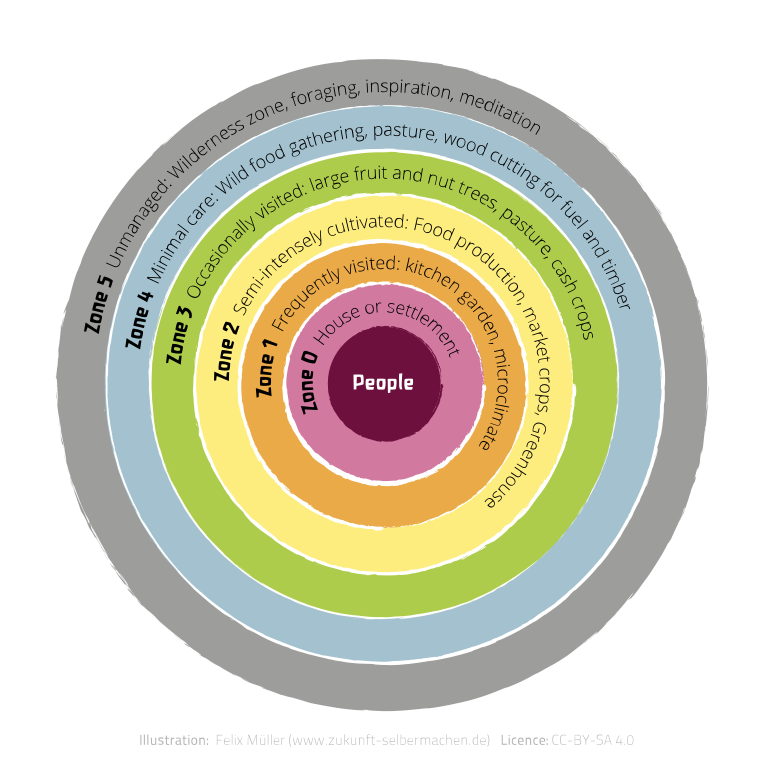
-
- Zoning Thought: Divide your yard into distinct zones primarily based completely on how typically you may entry or are inclined to totally utterly completely different areas. For example, Zone 1 is prone to be areas you go to day-to-day like herb gardens or kitchen gardens, whereas Zone 5 is vulnerable to be a wilder, self-maintaining space.
- Factors for Placement: Place parts that require frequent care or harvesting, equal to vegetable patches or salad greens, nearer to your individual house. This reduces the effort and time wanted for day-to-day gardening duties.
- Sector Evaluation: Perceive the surface influences in your yard, like photograph voltaic path, wind, wildlife corridors, and views. Arrange your yard sectors to maximise optimistic influences and cut back damaging ones.
- Creating Useful Areas: Design every zone for its particular perform. For instance, a greenhouse or chilly frames is vulnerable to be nearer to the home for simple entry in colder months, whereas composting areas is prone to be positioned additional away.
Environment nice Water Use:

-
- Rainwater Harvesting: Design your yard to seize and retailer rainwater. It will embrace inserting in rain barrels, making a cistern system, or utilizing rainwater for irrigation.
- Swales and Rain Gardens: Implement swales (shallow trenches) and rain gardens to seize and redirect rainwater. This not solely helps with water retention all through the soil nonetheless in addition to prevents erosion and runoff.
- Irrigation Methods: Use drip irrigation or soaker hoses for setting nice water use. These strategies ship water on to the muse zone of crops, minimizing evaporation and waste.
- Mulching: Apply pure mulch spherical crops to cut once more water evaporation from the soil, regulate soil temperature, and add pure matter to the soil because of it decomposes.
- Plant Various: Select crops which is prone to be suited to your space’s rainfall patterns and soil moisture ranges. Drought-tolerant crops normally is an effective alternative for areas with rather a lot a lot much less rainfall.
- Water-Good Yard Format: Design your yard development to study from pure slopes for water motion, and be aware of grouping crops with related water wants collectively to make watering further setting nice.
By meticulously planning and organizing your yard with these ideas, you create a further setting nice, productive, and sustainable permaculture surroundings.
This not solely advantages your crops and reduces workload nonetheless in addition to conserves property and helps the general successfully being of the ecosystem.
Creating Microclimates:
Creating microclimates inside your yard is a pivotal facet of permaculture, providing an revolutionary method to boost the productiveness and successfully being of your individual house.
By fastidiously manipulating parts like shade, windbreaks, and plant choice, you may create small, specialised areas inside your yard that cater to the distinctive wants of various crops.
This technique not solely optimizes rising situations nonetheless in addition to encourages a wealthy, fairly a number of ecosystem.
On this half, we’ll uncover varied methods to develop these microclimates, from utilizing pure parts for cover to diversifying vegetation.
Whether or not or not or not you’ve got received a sprawling yard or a modest yard, understanding and implementing microclimate methods can considerably enhance your yard’s resilience and yield.
Shade and Windbreaks:
-
- Strategic Planting for Shade: Benefit from better timber and tall shrubs to create shaded areas, which might defend further delicate crops from intense daylight. This may be notably helpful in scorching climates the place extreme photograph voltaic can stress crops.
- Types of Shade: Ponder quite a few kinds of shade, equal to dappled shade beneath deciduous timber or dense shade beneath evergreens, and select crops suited to every sort.
- Windbreaks: Plant timber and shrubs in a technique that they act as pure wind obstacles. It will defend your yard from sturdy winds, which might dry out soil and harm or stress crops.
- Layering for Safety: Use a layering methodology, with taller crops offering shelter for understory crops. This mimics pure forest situations and creates a further resilient ecosystem.
Plant Choice:
-
- Number of Species: Incorporate a variety of plant species with absolutely utterly completely different heights, enchancment habits, and root packages.
- This choice creates varied microclimates and habitats inside your yard.
Useful Combos:
Correct proper right here is further about plant mixtures that income one another come all via the context of making microclimates in a permaculture yard:
- Companion Planting: Benefit from companion planting methods the place sure plant mixtures assist one another’s enchancment. For instance, tall sunflowers can present shade for lower-growing, shade-tolerant crops. Marigolds, when planted close to greens, can deter pests with their sturdy scent.
- Nitrogen Fixers: Embody crops like legumes (beans, peas) that restore nitrogen all through the soil, benefiting neighboring crops. These is prone to be interplanted with nitrogen-hungry species, bettering soil fertility with out chemical fertilizers.
- Pest Administration: Plant herbs and flowers that naturally repel pests or entice helpful bugs. For instance, planting basil close to tomatoes may help repel flies and mosquitoes, whereas lavender can entice pollinators and helpful bugs.
- Floor Cowl Crops: Benefit from floor cowl crops to deal with soil moisture and stop weeds. For instance, planting clover or creeping thyme can present these advantages whereas furthermore along with aesthetic worth.
- Polycultures: Create polycultures by mixing quite a few kinds of crops collectively. It will within the discount of the unfold of pests and sicknesses, as they often choose monocultures. It furthermore ends in further setting nice use of house and property.
- Vertical Layering: Implement vertical layering by combining tall crops, mid-height shrubs, and floor covers. This creates a quite a few habitat and microclimate, profiting from vertical house.
- Microclimate Buffering: Some crops can buffer the microclimate for others. For example, a row of hardy shrubs can defend further delicate crops from harsh winds, making a further hospitable microclimate behind them.
Incorporating these helpful mixtures not solely enhances the successfully being and productiveness of a permaculture yard nonetheless in addition to contributes to the creation of fairly a number of and resilient microclimates.
This technique ends in a further balanced and self-sustaining ecosystem all via the yard.
Maximizing Residence:
Maximizing house effectively is a cornerstone of permaculture gardening, notably necessary for these working with restricted areas.
By innovatively utilizing each inch of accessible house, you may rework even the smallest yard or balcony correct proper right into a lush, productive haven.
On this half, we delve into good and ingenious methods like vertical gardening, layering, and companion planting.
These methods not solely improve the effectivity of your yard nonetheless in addition to add aesthetic worth and choice.
Whether or not or not or not you’re cultivating a tiny metropolis balcony or a compact yard, these space-maximizing concepts will empower you to create a thriving permaculture yard, wealthy in alternative and sustainability.
Vertical Gardening:
-
- Trellises and Arbors: Benefit from trellises, arbors, and utterly completely different vertical buildings to develop climbing crops like beans, peas, and vining flowers. This not solely saves floor house nonetheless in addition to offers an aesthetic dimension to the yard.
- Wall Planters: Be part of planters to partitions or fences to develop herbs, small greens, and flowers. That is significantly surroundings pleasant in metropolis settings the place floor house is restricted.
- Hanging Baskets: Use hanging baskets for crops like strawberries, cherry tomatoes, and trailing flowers. They’re wonderful for balconies and patios, making use of overhead house.
- Vertical Pallet Gardens: Recycle picket pallets into vertical planters for small, shallow-rooted crops. This technique is each space-efficient and eco-friendly.
Layering and Companion Planting:
-
- Cowl Layer: Begin with taller timber or shrubs because the quilt layer. This layer presents shade and creates a microclimate for the layers beneath.
- Understory Layer: Beneath the quilt, plant shrubs or taller perennials. This layer advantages from the moderated gentle and wind situations created by the quilt.
- Herbaceous Layer: Embody a wide range of herbs and flowering crops that thrive all through the situations created by the higher layers. These crops can entice helpful bugs and enhance soil successfully being.
- Floor Cowl Layer: Benefit from low-growing crops to cowl the soil, serving to to retain moisture, suppress weeds, and stop soil erosion.
- Companion Planting Advantages: Fastidiously choose plant mixtures that income one another. For instance, planting garlic close to roses may help deter pests, and rising carrots and onions collectively can mutually defend in opposition to sure pests.
- Root Choice: Incorporate crops with absolutely utterly completely different root depths to maximise nutrient uptake from absolutely utterly completely different soil layers and within the discount of rivals for property.
- Microclimate Optimization: Use companion planting to create favorable microclimates. For example, taller crops can present important shade for added delicate, lower-growing crops.
By effectively using vertical gardening and layered planting with companion crops, even the smallest gardens can grow to be terribly productive and fairly a number of.
This technique not solely maximizes using accessible house nonetheless in addition to creates a further dynamic and interactive yard ecosystem.
Integrating Wildlife:
Integrating wildlife into your permaculture yard is bigger than solely a technique to bolster its magnificence; it’s a serious step throughout the route of making a balanced and sustainable ecosystem.
On this half, we’ll uncover how attracting helpful bugs, birds, and utterly completely different wildlife can enrich your yard’s successfully being and resilience.
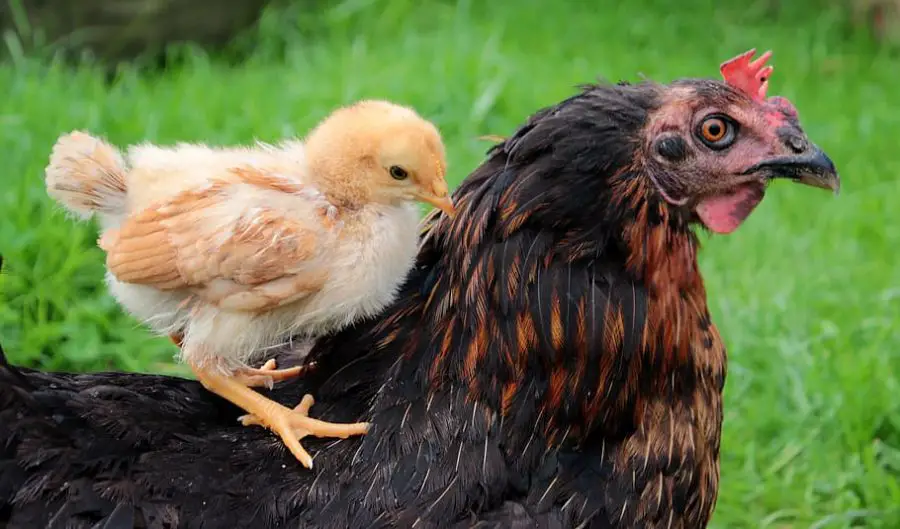
From planting native flora to rising habitats like bee motels and chook baths, every ingredient performs a major place in nurturing biodiversity.
Embracing these practices not solely helps native wildlife nonetheless in addition to contributes to pure pest administration and pollination, making a harmonious and thriving yard surroundings for all its inhabitants.
Attracting Useful Bugs:
-
- Native Plant Various: Select native crops which is prone to be significantly partaking to native pollinators, like bees, butterflies, and helpful wasps. Native crops are tailored to native insect populations and infrequently require rather a lot a lot much less upkeep.
- Fairly a number of Flowering Crops: Incorporate a wide range of flowering crops that bloom at absolutely utterly completely different occasions all 12 months prolonged. This presents a delicate meals present for pollinators.
- Insectary Crops: Embody crops notably acknowledged for attracting helpful bugs. For example, crops like yarrow, dill, and fennel are good for attracting ladybugs, which assist administration aphids.
- Avoiding Pesticides: Chorus from utilizing chemical pesticides, as they’re going to hurt helpful bugs. Go for pure pest administration strategies to deal with a healthful insect inhabitants.
Creating Habitats for Wildlife:
-
- Fowl Baths and Water Selections: Organize chook baths or small water selections, which not solely entice birds nonetheless in addition to present water for bugs and utterly completely different small wildlife. Guarantee to maintain the water clear and replenish it repeatedly.
- Bee Lodges: Create or prepare bee motels to provide nesting internet sites for solitary bees. These bees are nice pollinators and play an essential place all through the ecosystem.
- Log Piles and Brush Shelters: Go away piles of logs or brush in a quiet nook of your yard. These present habitats for a wide range of creatures, equal to beetles, frogs, and small mammals, which contribute to a balanced ecosystem.
- Wildflower Meadows: If house permits, designate an space as a wildflower meadow. This not solely offers magnificence to your yard nonetheless in addition to offers a habitat for wildlife.
- Hedge Borders: Plant hedges as an alternative of creating fences. Hedges present shelter and nesting internet sites for birds and small mammals.
- No-Disturbance Zones: Allocate areas in your yard the place you enable nature to take its course. These undisturbed areas can grow to be protected havens for wildlife.
- Plant Layer Choice: Protect a wide range of plant layers (cowl, shrubs, floor cowl) to cater to totally utterly completely different species of birds and bugs.
By integrating these parts correct proper right into a permaculture yard, you not solely improve the biodiversity of your individual house nonetheless in addition to contribute to a further healthful, further sustainable ecosystem.
These practices create a yard that’s not merely productive for human use nonetheless in addition to a thriving habitat for native wildlife.
Permaculture Yard Concepts Key Takeaways:
- Advantages of Permaculture: Highlights eco-friendly, low-maintenance gardening.
- Fashionable Designs: Focuses on companion planting and native species.
- Sustainability and Upkeep: Emphasizes pure ecosystems for easier repairs.
Understanding Permaculture Ideas:
Permaculture: A Designers’ Handbook
Permaculture is a sustainable gardening methodology aligning with pure ecosystems.
We delve into its essence and foundational ideas, guiding gardeners in route of an eco-friendly and aware cultivation observe.
What’s a Permaculture Yard?
Permaculture gardens are grounded in sustainable, self-sufficient ecosystems. They emphasize choice, mimic nature, and prioritize long-term environmental successfully being.
By integrating flora, fauna, and pure parts, these gardens create harmonious environments helpful for nature and gardeners.
Core Pointers of Permaculture:
Central to permaculture are ideas specializing in earth care, waste minimization, and mutually helpful relationships between gardeners and the surroundings.
These ideas foster respect for pure property, supporting a sustainable life-style helpful to each land and its inhabitants.
Permaculture Yard Design:
Gaia’s Yard: A Information to Dwelling-Scale Permaculture
Designing a permaculture yard goes earlier planting. It’s about crafting an ecosystem the place parts synergize. This part explores plant choice and yard house design, aligning with permaculture’s sustainable ethos.
Deciding on Crops for Permaculture:
Deciding on related crops is critical. Go for native species and companion planting to bolster widespread yard successfully being.
This system promotes mutual plant assist, reduces synthetic fertilizers and pesticides, and enhances biodiversity.
Designing Your Yard Residence:
Permaculture yard design considers your individual house’s pure traits. Perceive daylight, shade, wind, and water patterns.
Mimicking pure packages, grouping similar-need crops, and leveraging panorama selections fosters a thriving ecosystem.
Implementing Permaculture in Fairly a number of Areas:
Permaculture adapts to take care of and placement. We provide good selections for metropolis gardeners and different individuals in fairly a number of climates, demonstrating permaculture’s versatility.
Permaculture for Small Areas:
Metropolis permaculture maximizes restricted areas with vertical, container, and rooftop gardens. It reveals permaculture’s feasibility in constrained areas, affirming that sustainable gardening matches any setting.
Permaculture in Fully utterly completely different Climates:
Permaculture matches varied climates, from arid to temperate. The required issue lies in deciding on climate-appropriate crops and designing to leverage pure native local weather advantages, guaranteeing a flourishing yard in any surroundings.
Key Parts in Yard Planning:
Understanding soil and water is essential in permaculture. We offer insights into most attention-grabbing practices for soil preparation and setting nice water administration, necessary for a productive permaculture yard.
Soil Preparation and Properly being:
Healthful soil, wealthy in pure matter, is a cornerstone of permaculture. Methods like composting, no-dig gardening, and pure soil amendments improve fertility, supporting a vibrant, self-sustaining ecosystem.
Caring for and along with to the soil is probably the one and most profound piece of gardening suggestion I might give, and for me, as with many various practitioners, that is rooted all through the implication of no-till and/or one-dig yard beds. Sheet mulching is probably the perfect and quickest path to get there, notably for individuals who have already got an abundance of yard offers. Permaculture Information
Water Administration:
Environment nice water administration in permaculture consists of capturing rainwater, utilizing mulch to deal with moisture, and implementing irrigation packages like drip irrigation.
These practices guarantee surroundings pleasant water use, decreasing reliance on exterior sources, and sustaining a balanced yard ecosystem.
Ingenious Permaculture Concepts:
Permaculture blends effectivity with creativity and innovation. Utilizing distinctive gardening methods and concepts, equal to accessibility points and the lasagna gardening methodology, add choice and ease to the permaculture yard.
Accessibility in Permaculture:
Incorporating raised beds and container gardens enhances accessibility, making gardening further approachable for folk with mobility components.
These strategies furthermore present better soil top of the range administration and easier upkeep.
Lasagna Gardening Methodology:
Lasagna gardening is a no-till, layering methodology for creating fertile soil with minimal effort.
It comprises layering pure gives, which decompose to kind nutrient-rich soil, wonderful for a permaculture yard.
Superior Methods for Backyards:
Superior permaculture methods elevate your yard with delicate sustainability and self-sufficiency strategies.
This half covers designing a permaculture yard and the significance of a closed-loop system with no waste.
Designing a Yard Permaculture Yard:
Planning and remark are key in making a yard permaculture yard.
Perceive your land’s dynamics and blend them into your design for a productive, sustainable house.
Useful helpful useful resource Effectivity and Zero Waste:
Permaculture targets for a closed-loop system, minimizing waste. This consists of composting pure waste, utilizing renewable property, and designing the yard to grow to be a self-sustaining ecosystem.
FAQs
In our FAQs half, we take care of a variety of normally requested questions on permaculture gardening.
This informative part is designed to provide worthwhile insights and good suggestion for each rookies and seasoned gardeners.
Whether or not or not or not you’re curious regarding the fundamentals of permaculture, looking for options for implementing these ideas in varied settings or seeking to deepen your understanding of sustainable gardening practices, you’ll uncover choices correct proper right here.
This half targets to demystify permaculture and empower gardeners of all ranges to create further productive, eco-friendly, and self-sustaining gardens.
Q: What’s Permaculture Gardening?
A: Permaculture gardening is a sustainable methodology to landscaping that works in concord with nature.
It’s about making a self-sufficient ecosystem emphasizing biodiversity, soil successfully being, and useful helpful useful resource conservation.
This system integrates crops, animals, and pure parts to develop a productive and balanced surroundings.
Q: How Can I Begin a Permaculture Yard in a Small Metropolis Residence?
A: Beginning a permaculture yard in a small metropolis house comprises maximizing vertical house, utilizing container gardening, and deciding on crops suited to your particular microclimate.
Benefit from balconies, rooftops, and even window sills. Deal with companion planting and setting nice water use to learn from restricted house.
Q: Can Permaculture Methods Enhance My Yard’s Sustainability?
A: Sure, permaculture methods can considerably enhance your yard’s sustainability. By mimicking pure ecosystems, utilizing native property appropriately, and selling biodiversity, permaculture gardens require fewer exterior inputs and create rather a lot a lot much less waste, thereby enhancing sustainability.
Q: What Are the Key Pointers of Permaculture Design?
A: The required issue ideas of permaculture design embrace observing and interacting with nature, catching and storing power, shopping for a yield, making use of self-regulation, utilizing and valuing renewable property, producing no waste, designing from patterns to particulars, integrating fairly than segregating, utilizing small and sluggish selections, utilizing and valuing choice, utilizing edges and valuing the marginal, and creatively utilizing and responding to fluctuate.
Q: How Does Permaculture Income Native Wildlife and Biodiversity?
A: Permaculture advantages native wildlife and biodiversity by creating habitats that assist varied species.
Incorporating native crops, water selections, and pure practices attracts helpful bugs, birds, and utterly completely different wildlife, enhancing the ecological steadiness and successfully being of the yard and surrounding areas.
Q: How Can I Implement Water-Saving Methods in My Permaculture Yard?
A: Implement water-saving methods through the use of drip irrigation, rainwater harvesting packages, mulching, and planting drought-resistant species.
Design your yard development to optimize water use and retention, equal to through the creation of swales and rain gardens.
Q: What Function Do Companion Crops Play in Permaculture?
A: Companion crops play an essential place in permaculture by enhancing soil successfully being, deterring pests, attracting helpful bugs, and bettering plant enchancment.
They create symbiotic relationships, the place crops assist one another’s wants, resulting in a further resilient yard ecosystem.
Q: Why Permaculture?
Permaculture promotes pure rising packages, pure dwelling, and environmental steadiness.
It educates on native bioregions, native climate, and fertility, serving to cut once more stress, consumption, waste, and air air air pollution.
Q: What’s Permaculture Gardening?
A: Permaculture gardening is a sustainable methodology to landscaping that works in concord with nature.
It’s about making a self-sufficient ecosystem emphasizing biodiversity, soil successfully being, and useful helpful useful resource conservation.
This system integrates crops, animals, and pure parts to develop a productive and balanced surroundings.
Q: How Can I Begin a Permaculture Yard in a Small Metropolis Residence?
A: Beginning a permaculture yard in a small metropolis house comprises maximizing vertical house, utilizing container gardening, and deciding on crops suited to your particular microclimate.
Benefit from balconies, rooftops, and even window sills. Deal with companion planting and setting nice water use to learn from restricted house.
Q: Can Permaculture Methods Enhance My Yard’s Sustainability?
A: Sure, permaculture methods can considerably enhance your yard’s sustainability.
By mimicking pure ecosystems, utilizing native property appropriately, and selling biodiversity, permaculture gardens require fewer exterior inputs and create rather a lot a lot much less waste, thereby enhancing sustainability.
Q: What Are the Key Pointers of Permaculture Design?
A: The required issue ideas of permaculture design embrace observing and interacting with nature, catching and storing power, shopping for a yield, making use of self-regulation, utilizing and valuing renewable property, producing no waste, designing from patterns to particulars, integrating fairly than segregating, utilizing small and sluggish selections, utilizing and valuing choice, utilizing edges and valuing the marginal, and creatively utilizing and responding to fluctuate.
Q: How Does Permaculture Income Native Wildlife and Biodiversity?
A: Permaculture advantages native wildlife and biodiversity by creating habitats that assist varied species. Incorporating native crops, water selections, and pure practices attracts helpful bugs, birds, and utterly completely different wildlife, enhancing the ecological steadiness and successfully being of the yard and surrounding areas.
Q: How Can I Implement Water-Saving Methods in My Permaculture Yard?
A: Implement water-saving methods through the use of drip irrigation, rainwater harvesting packages, mulching, and planting drought-resistant species.
Design your yard development to optimize water use and retention, equal to through the creation of swales and rain gardens.
Q: What Function Do Companion Crops Play in Permaculture?
A: Companion crops play an essential place in permaculture by enhancing soil successfully being, deterring pests, attracting helpful bugs, and bettering plant enchancment.
They create symbiotic relationships, the place crops assist one another’s wants, resulting in a further resilient yard ecosystem.
Q: How Does Permaculture Differ from Typical Agriculture?
A: Permaculture differs from commonplace agriculture in its methodology to land use and useful helpful useful resource administration.
It emphasizes sustainable, ecological practices that work in concord with nature, specializing in biodiversity, soil successfully being, and useful helpful useful resource conservation, in distinction to the normally further resource-intensive and monoculture-based strategies of unusual agriculture.
Q: Can Permaculture Be Practiced in Metropolis Areas?
A: Sure, permaculture is prone to be effectively practiced in metropolis areas.
Methods equal to rooftop gardening, vertical gardening, and container gardening enable metropolis dwellers to create productive, sustainable gardens in small areas, contributing to native meals manufacturing and inexperienced areas all through the metropolis.
Q: How Can Permaculture Contribute to Meals Safety?
A: Permaculture contributes to meals safety by selling sustainable, native meals packages which is prone to be resilient to native local weather and environmental modifications.
Its ideas of choice, soil successfully being, and setting nice useful helpful useful resource use guarantee a gradual, sustainable current of meals, decreasing dependence on large-scale, enterprise agriculture.
Q: How Does Permaculture Assist in Combatting Native local weather Change?
A: Permaculture helps battle native local weather change by selling practices that within the discount of carbon emissions and improve carbon sequestration.
Sustainable land administration, using renewable property, and the low value of waste and chemical inputs contribute to decreasing the general carbon footprint of agricultural practices.
Permaculture designs ecosystems that mimic pure patterns, enhancing biodiversity.
It makes use of polyculture and native species to assist fairly a number of crops, animals, and microorganisms, boosting ecosystem resilience.
Conclusion: A Sustainable Future with Permaculture Gardening
As we conclude our exploration of permaculture gardening, it’s clear that this system is bigger than solely a gardening technique; it’s a pathway in route of a sustainable and harmonious future.
Embracing permaculture ideas in our gardens and communities ends in further healthful ecosystems, promotes biodiversity, and contributes to a further resilient surroundings.
On this remaining half, we mirror on the transformative vitality of permaculture, the way in which by which it redefines our interplay with nature, and its place in shaping a greener, further sustainable world.
Whether or not or not or not in metropolis settings or rural expanses, permaculture offers good and surroundings pleasant selections for environmental challenges, encouraging us all to be stewards of the Earth.
Embracing Permaculture:
Permaculture is bigger than gardening; it’s a path to sustainable dwelling and environmental stewardship. This technique integrates ecological ideas, creating productive, environmentally aware packages.
Adaptability and Accessibility:
Permaculture’s adaptable nature makes it accessible to all, encouraging metropolis and rural gardening. Its practices assist battle native local weather change, improve meals safety, and promote biodiversity.
A Establish to Motion:
The rising permaculture motion invitations people to actively take part in making a sustainable, regenerative future. This holistic methodology to gardening fosters a deeper reference to the surroundings, encouraging a greener planet.






